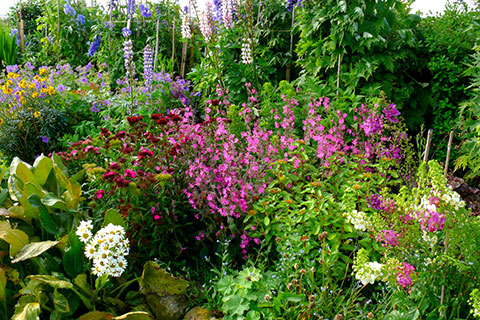- Start small. It’s sensible to keep a bit of perspective when starting out with a cottage garden – so perhaps start with a corner first and then allow the area to increase as your confidence (and the plants!) grow.
- Meandering paths are the perfect way to add interest while breaking up heavy planted beds. Curving them through beds and under trees can add a bit of a “Secret Garden” feel too. Use wood chips, stone, old bricks or flagstone and be sure to steer away from straight lines.
- Classic arches, trellis, arbours and pergolas are a great way to accent gates and seating while adding height to your space. They’re perfect for growing climbers on which will also add to the theme.
- Random planting is the name of the game for a cottage garden. Plant a little of what you fancy, where you fancy it, and be sure to pack your seeds or bedding plants in densely so each bedded area is overflowing with pretty plants and flowers.
- A cacophony of colour is essential. Pastel shades work well and reflect the harmonious and romantic theme, while hot reds, oranges and yellows draw the eye. Choosing to repeat single or multiple colours can help bring the varied planting style of this garden into harmony. This will help your garden look less messy but more like organised, glorious chaos.
- Don’t just focus on flowers. The historic purpose of this type of garden was as much about the kitchen as the garden – fruit, vegetables and herbs are all in keeping with the theme, so it’s worth exploring these too.
- Antique or vintage accessories can be fun to source and are perfect, especially if they appear a little rustic in style. Watering cans, old wheelbarrows (which can work particularly well as planters), weather vanes and sundials are ideal additions.
- Flowers should be sown in reckless abundance. Don’t worry too much about sticking to a particular design or sowing seeds in particular lines or symmetrical patterns – enjoy experimenting and creating.
- Go for romance. Fragrant scents and pastel colours are hallmarks of the cottage garden, while romantic plants such as roses will add a whimsical feel.
- Most garden designs require plants to be well spaced – not the case with a cottage garden. Sow flower seeds close together so that the soil is hidden and all the flowers knit together to create a mass of foliage.



Cottage garden
Reminiscent of quintessential English countryside gardens, the romantic cottage garden look is as beautiful as it is easy to achieve. While many specific garden looks depend on order and organisation, this is a rich tapestry of colours, scents and flowers in abundance which focuses more on creating something you love, rather than sticking to predefined rules about how the space should look.
Cottage gardens are filled with an array of different aspects - flowers that bloom at different times throughout the year, a herb patch to aid cooking, as well as overgrown borders that would, in other circumstances look messy. But that’s part of the joy of a space in this style - it’s aesthetically pleasing but takes little effort to establish or maintain. While the first rule of the cottage garden club is that there are no rules, this guide will give you a few pointers on getting the look you’ve always dreamed of.
Top 10 design tips
The finishing touches
Cottage gardens are as much about how they make you feel as how they look – so for the finishing touches, be sure to include wooden benches or rustic furniture so you can sit and enjoy your handi-work. Rustic pots and mismatching furniture will add to the bucolic feel of your garden too. Cottage gardens should be enclosed with picket or lattice fences that are usually not as tall as modern fences and vines such as Clematis, Wisteria, and Climbing Roses can be added too.







